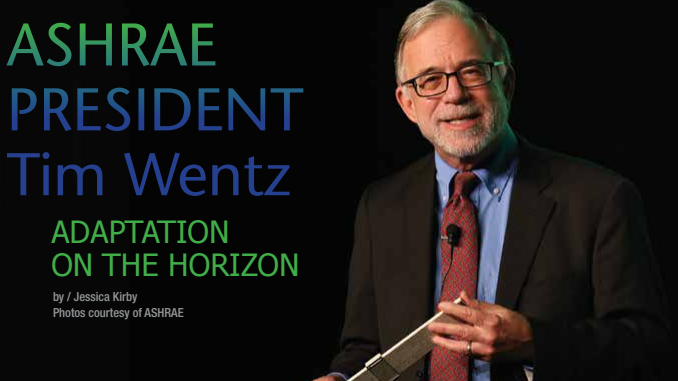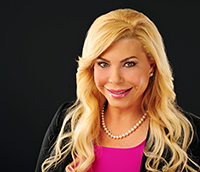ASHRAE President for 2016-17, Tim Wentz, hinged his presidential theme on the absolutely critical need for adaptation in today’s rapidly changing building design and construction landscape.
Kicking off his presidential theme speech wielding a slide rule – once an essential part of his life and later the catalyst for change – Wentz moves through ASHRAE’s main directives for his term, and the initiatives that will back them, coming back time and again to the need for adaptation.
“The greatest risk we face is resistance to change,” he says. “Our ability to shape tomorrow is borne out of our willingness to adapt today.”
Sheet Metal Journal caught up with Wentz with interest in how the need for adaptation translates into success for contractors, and to discuss challenges and opportunities the globally changing future will bring to the industry.
Wentz is an associate professor in construction management at the University of Nebraska – Lincoln. He earned a Bachelor of Science in Mechanical Engineering and a Master’s in Business Administration from the University of Nebraska. When he joined his family’s mechanical contracting firm, he developed expertise in mechanical design, estimating, and construction management over 19 years in the industry.
He knows what he is talking about when he says the construction industry has historically been slow to change—a real dilemma for integrating the concept of adaptation, since it hinges on the willingness to evolve.
“In my mind this is such a paradox because contractors are risk takers,” said Wentz. “They know how to take a risk; that is what they do with their lives.”
As a fourth generation contractor, Wentz knows the drill, and understands the reticence to adopt new technology. “We are a very traditional industry,” he said. “Tradition weighs heavily with us—more so than it should.”
The other driver for resistance to change is the industry being populated by smaller firms, which tend to look at the costs associated with change. How, then, to express the absolutely critical need for adaptation?
“My grandfather was fond of saying, ‘In business, there are two states of being: growth and decay. That is it,’” said Wentz. “I think he was 100 per cent right. We have to convince our fellow contractors that the rate of change is expanding and unless they expand with the change, they will be left behind.”
The same is true of ASHRAE, of course, and of all professional associations—a message Wentz consistently tries to get out to audiences.
“I often ask them to think of Uber and how it completely changed thelandscape,” he said. “The question becomes: who is your Uber? They are out there. We all know it. How will that change the way you do business and can you adapt?”
He reiterates from his theme speech, “The greatest risk we face is resistance to change. We just need to convince our fellow contractors they are really good at handing risks and they can handle this risk, too.”
A second key directive of Wentz’s presidential theme is the need to “be in the room”—that is, participate in industry associations, meetings, networking events, and other gatherings where specifiers, suppliers, the competition, and other industry associates will be.
Wentz said three main trends in the industry are making it essential that contractors “be in the room”.
First, there is a change in technology coming down the pipe that will transform the way buildings are designed and constructed. Once the technology change occurs, for the first time the industry will actually be able to do integrated design—something that isn’t currently done particularly well or often enough.
“We don’t really have the technology yet to optimize that process,” he said. “When the technology comes, integrated design will be the way we do things in the future.
“The heart of integrated design is having everyone at the table during the design and construction process, including sheet metal, plumbing, and heating contractors, operations and maintenance people, owners, architects, and engineers,” he said. “The whole lifecycle of the building needs to be represented if we are to produce an integrated design.”
Once the technology and integrated design are in place, designers will design and build buildings based on performance, which is completely different from the current method.
“Previously, we have done things in a prescriptive manner, referring to building codes and standards to achieve specific efficiencies,” said Wentz. “That will all go away. It is going to be a much more systems approach based on how the building performs to meet clients’ expectations.”
This process will lead to what Wentz refers to as The Golden Age of the construction industry, something he believes is well on its way.
“That is why contractors have to be in the room,” he said. “And, it’s not just to develop networks and to be on these teams, but also to make their expertise available so the project can be successful.”
Although there is no denying the advantage of greener building systems, in some cases sustainability measures change the landscape in ways that demand adaptation. Smaller systems, ductless systems, and pipe and duct reconfiguration can actually shrink the traditional sheet metal scope, opening up room to fail or opportunities to evolve and grow.
“To write the word crisis,” said Wentz, “the Chinese take the pictogram for danger and write it with the pictogram for opportunity. I think that is a perfect
description of crisis. Successful contractors and engineers focus on the opportunities, and not the danger.”
The evolving landscape will indeed bring change—particularly in the form of global initiatives meant to lower our buildings’ impact on the environment.
“That will create stress and a great opportunity,” he said, citing the opportunity to hone the high-performance operations model needed to complete the building efficiency cycle.
“We spend a great deal of time figuring out how to do high-performance design and quite a bit on how to do high-performance construction,” said Wentz. “The missing piece is high-performance operations and maintenance. [Without these] it will never be a high-performance building.”
Another area is changing weather patterns and the opportunity to study how buildings respond to and recover from unusual weather events.
“It is never discussed, so it is an area of great opportunity,” he said. “There are other emerging areas like integrated design, building information modelling (BIM), and The Internet of Things—all of these things will create opportunities for our contractors.
“I’m excited about it. I understand risk is there, but the opportunity is really great.”
Into the future, regulatory and code issues will challenge contractors and demand the need for adaptation.
ASHRAE is currently researching flammable refrigerants, which have raised some concerns, but have proven lower in global warming and ozone depletion potential, while being more efficient than the refrigerants currently in use.
“We have to figure out how to use them and how to maintain them to building owners’ satisfaction so we can provide a safe environment and one that impacts our environment less and creates more efficiency,” said Wentz.
“These are just a few challenges on the board—these and others will create opportunities where contractors and engineers have to adapt and adapt quickly. They can’t be the last person to the table because there may not be a chair there.”
ASHRAE sees these same trends and its members are working hard to make “the room” bigger.
“Engineers, contractors, and architects have not done a great job in collaborating and we are trying very hard to make the room bigger so all three of us are better able to adapt as changes manifest,” said Wentz.
Read the full text of Wentz’s theme speech or watch the video at www.ashrae.org/Wentz.




